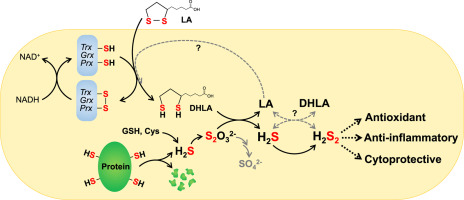当前位置:
X-MOL 学术
›
Free Radical Bio. Med.
›
论文详情
Our official English website, www.x-mol.net, welcomes your
feedback! (Note: you will need to create a separate account there.)
Are the beneficial effects of 'antioxidant' lipoic acid mediated through metabolism of reactive sulfur species?
Free Radical Biology and Medicine ( IF 7.1 ) Pub Date : 2019-10-30 , DOI: 10.1016/j.freeradbiomed.2019.10.410 Kenneth R Olson 1 , Austin Briggs 2 , Monesh Devireddy 2 , Ming Xian 3 , Yan Gao 2
Free Radical Biology and Medicine ( IF 7.1 ) Pub Date : 2019-10-30 , DOI: 10.1016/j.freeradbiomed.2019.10.410 Kenneth R Olson 1 , Austin Briggs 2 , Monesh Devireddy 2 , Ming Xian 3 , Yan Gao 2
Affiliation

|
The health benefits of lipoic acid (LA) are generally attributed to mitigating the harmful effects of reactive oxygen species (ROS). ROS are chemically similar to reactive sulfur species (RSS) and signal through identical mechanisms. Here we examined the effects of LA on RSS in HEK293 cells using H2S and polysulfide (PS) specific fluorophores, AzMC and SSP4. We show that LA concentration-dependently increased both H2S and PS. Physioxia (5% O2) augmented the effects of LA on H2S production but decreased PS production. Thiosulfate, a known substrate for reduced LA, and an intermediate in the catabolism of H2S enhanced the effects of LA on H2S and PS production. Inhibiting peroxiredoxins with conoidin A and gluraredoxins with tiopronin augmented the effects of LA on PS and H2S, respectively while decreasing glutathione with buthionine-sulfoximine (BSO) or diethyl maleate (DEM) decreased the stimulatory effect of LA on H2S production but augmented LA's effect on PS. Aminooxyacetate (AOA) and propargylglycine (PPG), inhibitors of H2S production from cysteine partially inhibited LA augmentation of H2S production and further decreased the LA effect when applied concurrently with BSO and DEM. The selective and cell-permeable H2S scavenger, SS20, inhibited the effects of LA on cellular H2S. Estimates of single-cell H2S production suggest that 0.1-0.2% of O2 consumption is used to metabolize H2S and these requirements may increase to 1-2% with 1 mM LA. Collectively, these results suggest that LA rescues H2S from irreversible oxidation and that the effects of LA on RSS directly confer antioxidant, anti-inflammatory and cytoprotective responses. They also suggest that TS may be an effective supplement to increase the efficacy of LA in clinical settings.
中文翻译:

“抗氧化剂”硫辛酸的有益作用是否通过活性硫物质的代谢介导?
硫辛酸(LA)的健康益处通常归因于减轻活性氧(ROS)的有害影响。ROS在化学上类似于反应性硫物质(RSS),并通过相同的机制发出信号。在这里,我们使用H2S和多硫化物(PS)特定的荧光团AzMC和SSP4检查了LA对HEK293细胞中RSS的影响。我们表明,LA浓度依赖性地增加了H2S和PS。生理性缺氧(5%O2)增强了LA对H2S产生的影响,但降低了PS产生。硫代硫酸盐(一种已知的可降低LA的底物)和H2S分解代谢的中间体可增强LA对H2S和PS产生的影响。用类固醇A抑制过氧化物氧还蛋白和用硫普罗宁抑制谷氨酰氧还蛋白增强了LA对PS和H2S的作用,分别用丁硫醇亚砜亚胺(BSO)或马来酸二乙酯(DEM)降低谷胱甘肽时,可降低LA对H2S产生的刺激作用,但可增强LA对PS的作用。当与BSO和DEM并用时,氨基氧乙酸盐(AOA)和炔丙基甘氨酸(PPG)是半胱氨酸产生H2S的抑制剂,部分抑制了LA对H2S产生的增加,并进一步降低了LA的作用。选择性和可渗透细胞的H2S清除剂SS20抑制了LA对细胞H2S的作用。单细胞H2S产生的估计表明,消耗O2的0.1-0.2%用于代谢H2S,而使用1 mM LA时,这些要求可能会增加到1-2%。总而言之,这些结果表明,LA可以挽救H2S免受不可逆的氧化作用,并且LA对RSS的作用直接赋予了抗氧化剂,抗炎和细胞保护反应。他们还建议,TS可能是增加LA在临床环境中疗效的有效补充。
更新日期:2019-11-01
中文翻译:

“抗氧化剂”硫辛酸的有益作用是否通过活性硫物质的代谢介导?
硫辛酸(LA)的健康益处通常归因于减轻活性氧(ROS)的有害影响。ROS在化学上类似于反应性硫物质(RSS),并通过相同的机制发出信号。在这里,我们使用H2S和多硫化物(PS)特定的荧光团AzMC和SSP4检查了LA对HEK293细胞中RSS的影响。我们表明,LA浓度依赖性地增加了H2S和PS。生理性缺氧(5%O2)增强了LA对H2S产生的影响,但降低了PS产生。硫代硫酸盐(一种已知的可降低LA的底物)和H2S分解代谢的中间体可增强LA对H2S和PS产生的影响。用类固醇A抑制过氧化物氧还蛋白和用硫普罗宁抑制谷氨酰氧还蛋白增强了LA对PS和H2S的作用,分别用丁硫醇亚砜亚胺(BSO)或马来酸二乙酯(DEM)降低谷胱甘肽时,可降低LA对H2S产生的刺激作用,但可增强LA对PS的作用。当与BSO和DEM并用时,氨基氧乙酸盐(AOA)和炔丙基甘氨酸(PPG)是半胱氨酸产生H2S的抑制剂,部分抑制了LA对H2S产生的增加,并进一步降低了LA的作用。选择性和可渗透细胞的H2S清除剂SS20抑制了LA对细胞H2S的作用。单细胞H2S产生的估计表明,消耗O2的0.1-0.2%用于代谢H2S,而使用1 mM LA时,这些要求可能会增加到1-2%。总而言之,这些结果表明,LA可以挽救H2S免受不可逆的氧化作用,并且LA对RSS的作用直接赋予了抗氧化剂,抗炎和细胞保护反应。他们还建议,TS可能是增加LA在临床环境中疗效的有效补充。











































 京公网安备 11010802027423号
京公网安备 11010802027423号